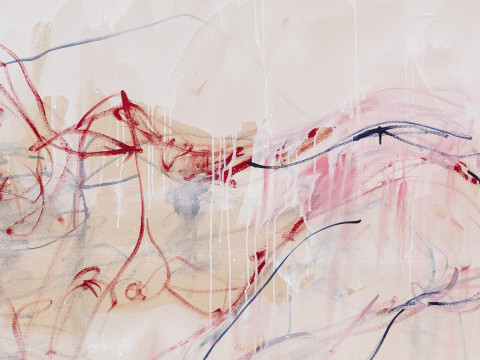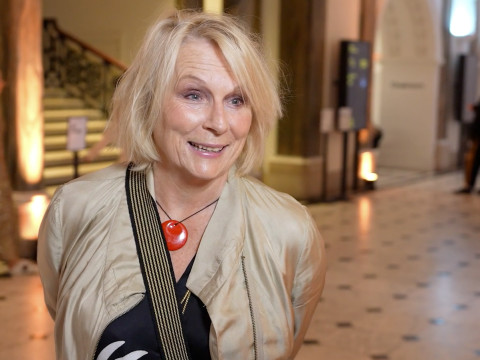
Studio life: tips from the Summer Exhibition artists
By RA digital team
Published on 12 July 2017
As part of our season exploring artists' studios, we asked the artists of the 2017 Summer Exhibition – from Royal Academicians to first-time exhibitors – to give us a peep inside their working space, and to share their secrets for a successful studio practice.
This article was originally published in 2016. Submit your work for the 2018 Summer Exhibition here.
The Summer Exhibition is the biggest open-submission exhibition in the world, displaying everything from works made by professional teams in purpose-built studios, to watercolours done at the kitchen table. We asked our artists to show us round their studios and let us in on their secrets for minimising distractions, finding inspirations and carving out a space where creativity can flourish. Here's what they said...
1. A studio can be anywhere

I work directly in the ocean
immersed in the water to find and produce my drawings. I do not have or use a conventional studio.

I love to draw on location:
city and landscape, night and day. Wherever I set-up my easel becomes my studio. This shot was taken in one of my more public "studios" – St Paul's Cathedral.

Our studio is the coast and half of a chapel
in Hartland; it's a great space. Pine Feroda is a group, we work together on large woodblock prints.
I’m currently using an extremely chaotic desk crammed into my bedroom and a dining table in my living room! I think artists will just use any space available to them. Nothing really stops us.
Michelle Dow
2. Decide whether you need solitude or sociable neighbours

I think of this space as an opportunity to invite people in.
My working life is part of the life I live – I’m not precious about shutting it off. I love being able to share my studio at the Royal Academy Schools too; students have been up here writing essays when they needed a quiet space. More from Eileen Cooper RA

I like to be immersed in silence.
I get lost in my work and I can be a bit messy, so it's good to have space to be able to just let go and paint and not worry about the mess until I'm back in reality. Having dedicated space to lose myself in unquestionably helps my work.

I'm in a wonderful art community
for art-making and that, for me, makes a successful studio. I'm based at Wysing Arts Centre. I think for any artist the most important element in a studio is the feeling that one gets from the space. I love my beautiful view of the countryside that I have all to myself.
The social aspect is also important – a few friends make a studio into a welcoming space.
Julian Sharples
3. If you work from home, claim your own space

I enjoy the "commute" up the garden
hearing birdsong instead of sirens. After 20 years of renting overpriced London studios, a move to the country freed up resources to build a studio of my own. My studio is fundamental to my life and makes me happy.

I make art in the Barbican
on the balcony of my flat. I like to engage with the world around me: as an anthropologist, audience, spectator, parent, friend. Making art is an essentially private, personal act. But I like to absorb the world around me when I work. My studio is my home and home is the City of London.

I climb a ladder and close the trap door
to immerse myself in a private space that sits above the surrounding roofs and has views out to the countryside beyond. My studio is a converted attic in a Victorian semi-detached house. It has enough room for me to both print my multi-block lino prints, and produce the oil paintings and veneer marquetry pieces I also make.
My space is purely a workshop. Total chaos. Not the kind of studio where I go in, make a cup of tea and smoke a pipe
Brian Catling RA
4. Choose somewhere you're prepared to stay all day

I move to an indoor room for the colder days.
My studio is a double garage conversion. The lighting isn’t perfect and it never will be because of the position of the house, but it seems to work. No point being too pernickety… just get on with it before it’s too late!

A good kettle is important!
I think a successful studio depends on how you feel in the space. You need to feel relaxed in the studio so you can concentrate, not to mention the practicalities of wifi and heating in the winter. I make most of my work on the floor, I always have done. I feel I can never run out of space when occupying the floor as a workspace.

Even in winter, my studio is a comfortable place to be.
I know people who have gone for cheap options, but they turn out to be cold and too far away so they hardly ever use them. My studio is at the top of a small office development in Birmingham. There are no distractions and all my materials are readily at hand, but it's less than five minutes away from where I live. Make sure you have enough space, because you will grow and need more room for materials and finished works.
Your first studio should always just be an experimental space to try out things. Requirements change as one progresses.
Hanna Ten Doornkaat
5. If you can't find what you need nearby, look further afield

I found time and space in Chile.
The Chilean capital is the perfect neighborhood for artists. My studio is in an old house in Matta Sur, Santiago. As a young artist developing a visual language, the most important things for me right now are time and space and I've found both of those things living and working in Chile.

Most of my work is produced outdoors on other people’s land
although I have a conservatory in my back garden where I paint all my still-lifes. There’s an orchard down the road, with a ruined old henhouse. I like to camp out there – I love the scruffiness. More from Olwyn Bowey RA.

My studio is like a kingdom for me.
I work in San Francisco. Since the oil paintings need to dry for weeks, I have enough space to dry the paintings while I can continue to paint new ones. I prefer to work alone in the studio. I have my favourite hand drums in there; they have helped me to get in the zone many times mentally.
My studio sits on the edge of the Thames on Eel Pie Island in a working boatyard, with a few other studios. As soon as I cross over the bridge to the Island my brain switches gear.
Melanie Miller
6. Your studio doesn't have to look like anyone else's

My studios let me indulge my delight
in the paraphernalia of art. Quality sketch books, boxes of watercolour tubes, pens and brushes – they are all a pleasure to handle. I paint in two converted sheds in a peaceful garden: one studio for drawing and watercolours and the other for oils and acrylics. Working in a garden environment provides a temporary isolation from everyday distractions, separating my art endeavours from domestic routine.

The studio is verging on chaos – I like it this way.
My studio is in a converted Victorian railway goods yard. Anything can happen here, it’s a world of possibilities. There are mountains of spoons, forks, tin cans, buttons everywhere and walls full of drawings. Images, shapes and ideas come to me from the crazy juxtapositions of unlikely materials.

When I go home at the end of each day
I can’t wait to get back here to start all over again. My studio overlooks the Thames Barrier in London. I’ve had larger studios in the past and I have to keep this studio in a certain order for it to work for me, but I love the calm and privacy of my own space.
Have studio tips to share? Post your advice and pictures with #StudioShots @royalacademy on Twitter or @royalacademyarts on Instagram.
Summer Exhibition artists' studio recommendations

Submit your work for the Summer Exhibition 2018
“Fellow artists! 2018 marks the 250th anniversary of the Royal Academy, so the Summer Exhibition will celebrate a quarter of a millennia of artistic innovation. As coordinator, I have decided that the theme of the show will be Art Made Now. I want to champion the democracy of the exhibition and show off the diversity of art being made in this moment, so I encourage you to submit works that you have made in 2017/18. I am also planning a special ‘Room of Fun’ in a newly built part of the Academy, so the committee may well look favourably on artworks that we find amusing.” – Grayson Perry RA.
The submission deadline is 11.59pm on Wednesday 14 February.


